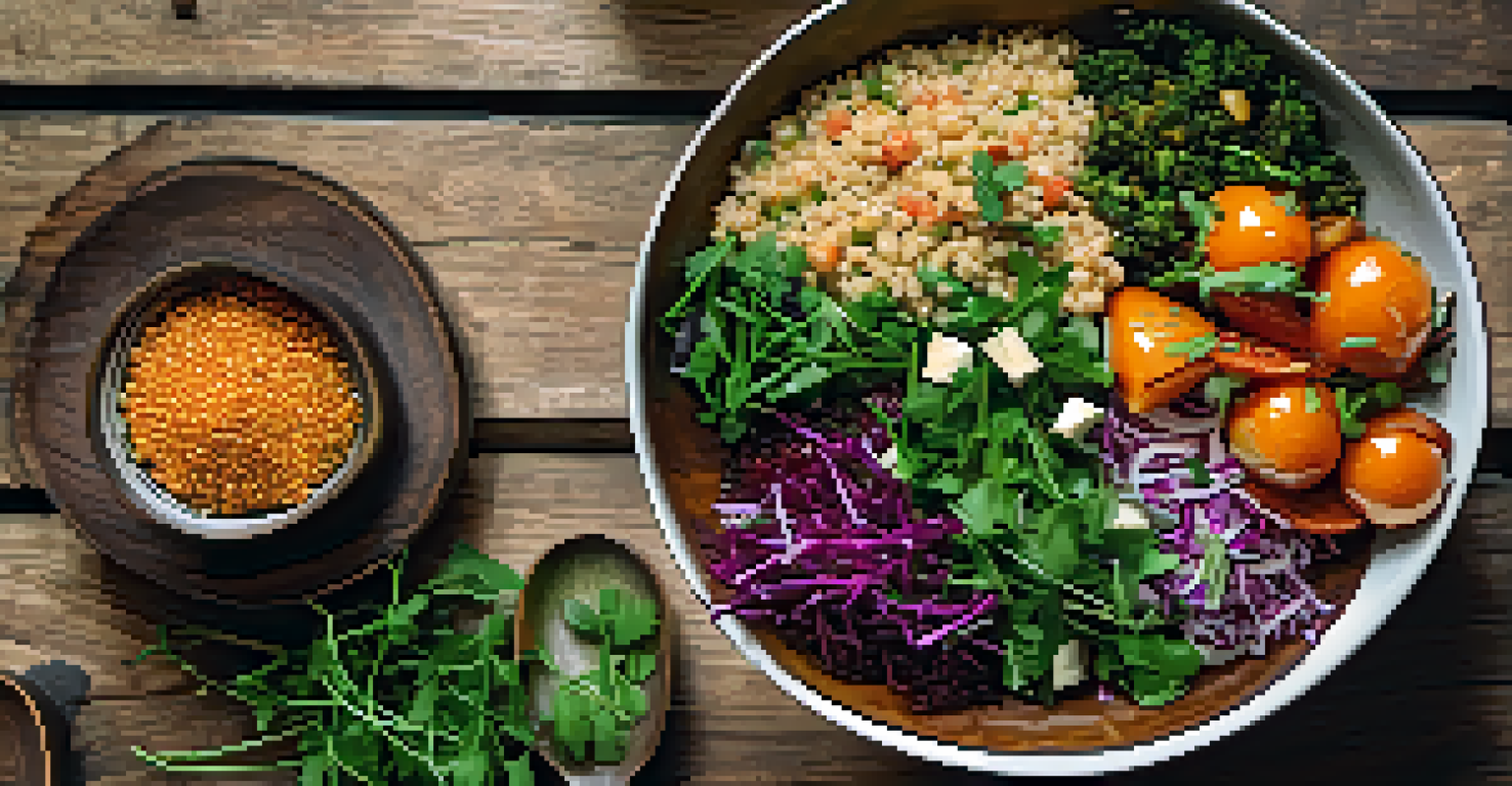How to Create a Sustainable Meal Plan for Better Health

Understanding Sustainable Meal Planning Basics
Sustainable meal planning is all about making choices that benefit both your health and the planet. It involves selecting ingredients that are nutritious, seasonal, and locally sourced whenever possible. By doing this, you reduce your carbon footprint while enjoying fresher, tastier meals.
Eating is an agricultural act.
Think of it like gardening; the more you focus on what grows naturally in your area, the better your meals will taste and the more you’ll contribute to a healthier environment. Not only does this approach support local farmers and economies, but it also encourages biodiversity, which is crucial for our ecosystem.
As you start your meal planning journey, keep in mind the importance of variety. Incorporating different foods not only keeps your palate excited but also ensures you're getting a wide range of nutrients necessary for your health.
Assessing Your Dietary Needs and Preferences
Before diving into meal planning, it's essential to assess your dietary needs and preferences. Are you following a specific diet, like vegetarianism or gluten-free? Understanding your nutritional requirements will help you create a meal plan that supports your health goals.

Consider keeping a food diary for a week to track what you eat and how it makes you feel. This practice can reveal patterns and help identify areas for improvement. Maybe you notice that you feel more energetic when you include whole grains or that certain snacks leave you feeling sluggish.
Embrace Local, Seasonal Foods
Choosing seasonal and locally sourced ingredients not only enhances meal flavor but supports local economies and reduces carbon emissions.
Ultimately, your meal plan should reflect what works best for your body and lifestyle. Remember, the goal is to create meals that you enjoy and that nourish you, making it easier to stick to your plan long-term.
Incorporating Seasonal and Local Ingredients
One of the cornerstones of a sustainable meal plan is using seasonal and local ingredients. Not only are seasonal foods usually fresher and tastier, but they also tend to be more affordable. Think about it: when produce is in season, it’s often harvested at its peak, offering the best flavor and nutrients.
The food you eat can be either the safest and most powerful form of medicine or the slowest form of poison.
Local farmers' markets are a fantastic resource for finding fresh ingredients. By shopping there, you support local agriculture and reduce transportation emissions, making your meals more sustainable. Plus, you might discover unique varieties of fruits and vegetables you wouldn’t find in a typical grocery store.
As you incorporate these seasonal ingredients, consider creating a rotating meal plan that changes with the seasons. This not only keeps your meals exciting but also ensures that you’re benefiting from the best that nature has to offer throughout the year.
Planning Your Weekly Meals and Snacks
Once you have a solid understanding of your dietary needs and seasonal ingredients, it's time to plan your meals and snacks. Start by selecting a few recipes that excite you and can be prepared in bulk, such as soups, stews, or grain bowls. This approach saves time and reduces food waste.
When planning your snacks, consider healthy options that are easy to prepare and transport. Think about items like hummus with carrot sticks, yogurt with fruit, or homemade energy bars. Having these snacks on hand can help you avoid unhealthy choices when hunger strikes.
Plan for Variety and Flexibility
Incorporating a diverse range of foods and allowing for spontaneous meal changes keeps your meal plan enjoyable and nutritious.
As you create your meal plan, leave some flexibility for spontaneity. Life can be unpredictable, and having the ability to swap meals or adjust recipes based on what you have at home can prevent frustration and keep your meal planning enjoyable.
Shopping Smart: Tips for Sustainable Grocery Trips
Shopping sustainably involves more than just choosing local and seasonal foods; it also means being mindful of your purchases. Create a shopping list based on your meal plan to reduce impulse buys and minimize waste. Stick to the perimeter of the store where fresh produce, meats, and dairy are usually found.
Consider bringing reusable bags to avoid single-use plastics, and check if your local store offers bulk bins for grains, nuts, and spices. Buying in bulk not only reduces packaging waste but also allows you to purchase only what you need, further minimizing food waste.
Additionally, don’t shy away from imperfect produce. These items are often just as delicious but may come at a lower price. By choosing them, you’re helping to combat food waste and making a more sustainable choice.
Cooking Techniques that Embrace Sustainability
How you cook can significantly impact the sustainability of your meals. Embracing techniques that conserve energy, such as batch cooking or using a slow cooker, can help reduce your overall energy consumption. These methods also allow flavors to meld beautifully, enhancing the taste of your dishes.
Another great tip is to use every part of your ingredients. For instance, vegetable scraps can be saved to make homemade broth, and herb stems can be blended into sauces. This not only minimizes waste but also adds depth to your meals.
Mindful Shopping and Cooking
Practicing sustainable shopping habits and energy-efficient cooking techniques helps minimize waste and supports a healthier planet.
Experimenting with plant-based cooking can also be a sustainable choice. Dishes centered around legumes, grains, and seasonal vegetables can be both satisfying and nutritious, while also requiring fewer resources compared to meat-based meals.
Evaluating and Adjusting Your Meal Plan Over Time
Creating a sustainable meal plan is an ongoing process that requires evaluation and adjustment. After a few weeks, take a moment to reflect on how your meal plan is working for you. Are you enjoying your meals? Are there ingredients that go unused? This reflection will help you refine your approach.
Don’t hesitate to make changes based on your preferences and seasonal availability. Flexibility is key to maintaining a plan that feels sustainable in both health and practice. If you find yourself bored with a meal, explore new recipes or cooking methods to keep things fresh.

Remember, sustainability is about progress, not perfection. Celebrate your achievements, no matter how small, and continue to make choices that contribute to your health and the health of the planet.